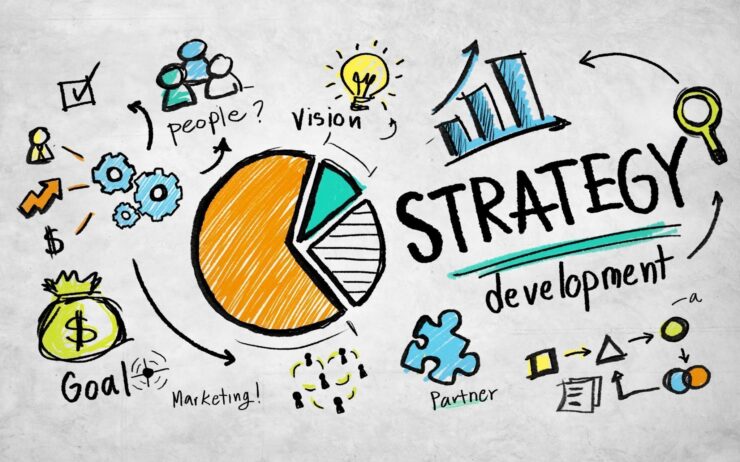As businesses strive to create meaningful connections with their customers, understanding how web design can be used to improve your marketing strategy has become ever more important. With the right approach and a creative vision, you can use web design to increase engagement and drive sales.
From crafting an engaging user experience through visuals and storytelling techniques to using search engine optimization tactics for greater visibility, this article will explore the art of engagement in web design and explain its impact on marketing success.
Crafting an Effective Marketing Strategy for Your Website
When it comes to crafting an effective marketing strategy for your website, web design plays a key role. A well-designed website can do more than just attract visitors; it can help build customer engagement and loyalty, leading to increased sales.
To ensure that your web design enhances your marketing strategy, consider the following tips: First and foremost, think about how you want visitors to interact with your site. What kind of content will engage them? How easy is it for them to navigate? Make sure all elements on the page are clear and concise — this means using visuals such as graphics or videos when appropriate.
Additionally, pay attention to what colors and fonts you use – these should be chosen carefully so they’re pleasant for users but also convey the message you want customers to receive. Next up is creating content that speaks directly to potential customers.
This could include blog posts related to their needs or interests; informative articles about current trends in the industry; or even helpful guides on topics like “how-tos” or tutorials related to products/services offered by your company. Whatever type of content you choose, make sure it’s engaging and encourages readers to take action (like visiting another page on the website).
Finally, don’t forget about social media! Connecting with people via platforms like Facebook or Instagram can prove invaluable when establishing a presence online – not only does this allow potential customers to find out more information about what you offer but allows them to reach out directly if necessary too! Social media is also great for building relationships with influencers who may further spread awareness of what you have going on which could lead to more followers/customers down the line!
Leveraging Visual Elements to Create an Engaging User Experience

The visual elements of a website can help create an engaging user experience and increase customer loyalty. Designing an attractive and functional website is one of the most important steps to creating an engaging user experience.
Through the use of compelling graphics, eye-catching colors, interesting typography, animations, video integration, and other visual design elements you can attract your customers’ attention and provide them with a memorable browsing experience. Web designers must consider how their chosen visuals will impact their target audience when designing websites.
Different demographics respond to different types of visuals in varying ways so understanding who your audience is will inform the kind of visuals used within the site design. For example, if you are targeting Millennials then using bold or bright colors may be more effective than muted tones as this age group has been proven to prefer bright hues.
When it comes to incorporating visuals into web designs its important for designers to remember that less is often more – ensuring all content on each page serves a purpose instead of overwhelming viewers with too much information at once helps foster engagement from visitors rather than discouraging them from exploring further into your site due its complexity or confusion caused by too many intrusive images or videos competing for attention at once. Creating visually appealing pages while keeping usability in mind ensures any website design can capture its visitor’s imaginations while still providing users with a seamless navigation system they can easily navigate through without feeling overwhelmed by excess imagery or superfluous animation effects vying for their attention all at once.
Utilizing simple yet beautiful designs featuring relevant content presented allows companies to ensure every element present engages with potential customers effectively – making sure no visitor leaves without gaining something valuable from their time spent on the site whether it be knowledge gained about products/services offered or simply inspiration taken away from unique imagery featured throughout certain pages!
Utilizing A/B Testing to Optimize Your Web Pages for Maximum Impact
When it comes to marketing a business, the web design of a website is often just as important as its content. A/B testing provides an effective way to optimize websites for maximum engagement with potential customers.
By creating two versions of each page, businesses can measure which version resonates most effectively with visitors. Through this process, businesses can identify areas where they can make changes to improve their overall impact on visitors and create better user experiences.
A/B testing also allows marketers to adjust elements such as copywriting and imagery that appear on webpages without having to completely rebuild them from scratch every time something needs changing. This helps save time and energy while still allowing for meaningful improvements that will help generate more leads or sales conversions over time.
Additionally, by running tests continuously, marketers can ensure that their pages remain engaging and relevant even when trends in customer behavior start shifting due to external factors like seasonality or industry changes. In conclusion, utilizing A/B testing is an essential part of any successful web design strategy aimed at maximizing engagement with potential customers online.
By quickly understanding how users interact with different elements of a website, businesses can make informed decisions about what works best for them and optimize their pages accordingly – leading ultimately towards higher levels of success in terms of lead generation or sales conversion rates over time!
Analyzing Data and Measurement Strategies to Track Performance Results

When it comes to analyzing data and measuring strategies to track performance results, web design plays an important role in the success of any marketing strategy. With modern technology at our fingertips, tracking user engagement is easier than ever before.
Web analytics tools can help marketers understand how users are interacting with their websites and pinpoint areas that need improvement. Additionally, A/B testing can be used to determine which elements on a page best engage visitors and lead them further down the sales funnel.
By utilizing these tactics, businesses can develop more effective content based on real-time customer feedback. This process helps ensure that all online marketing efforts are targeted precisely toward potential customers who are most likely to purchase or convert into leads.
Furthermore, using data collected from tracking metrics such as bounce rate and time spent on the page enables companies to make informed decisions about their web design investments – allowing for maximum return on investment (ROI). Ultimately, understanding how people interact with websites allows for smarter decisions when it comes to budget allocation across different channels within a digital marketing campaign.
By combining sophisticated analysis techniques with meaningful insights gleaned from user behavior measurements businesses can improve upon their existing web design strategies – resulting in increased conversions and better ROI overall.
Conclusion
Web design is a powerful tool for businesses to use when it comes to marketing. It can be used to create an immersive experience that engages customers and encourages them to learn more about your products or services.
With the help of CSME Marketing, companies can create a website that not only looks great but also works towards achieving their marketing goals. The art of engagement through web design allows brands to reach new customers, build relationships with existing ones, and ultimately grow their business in the long term.


